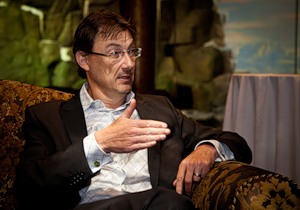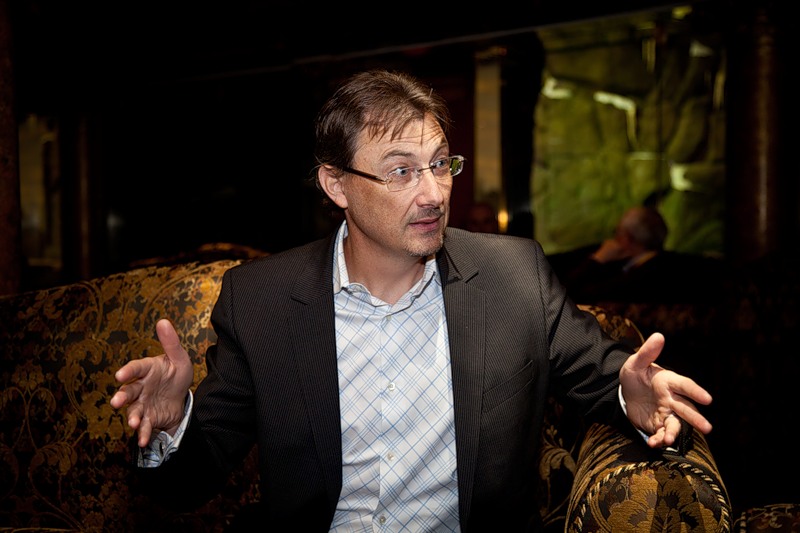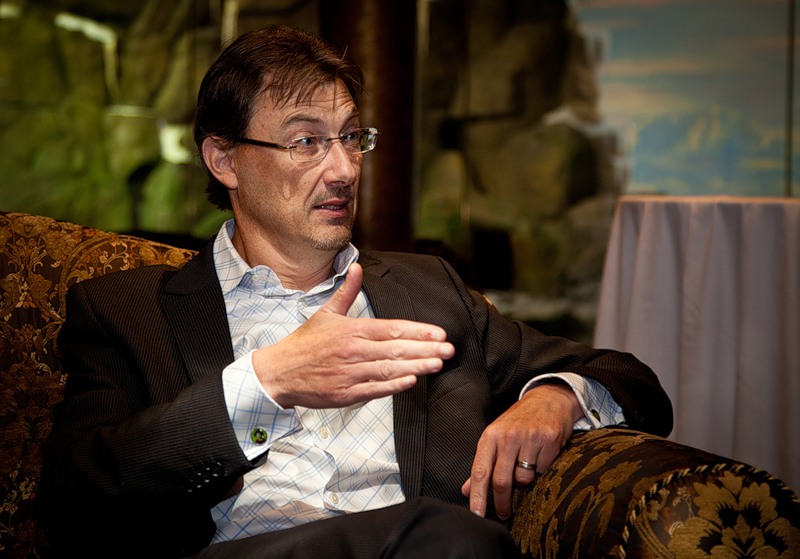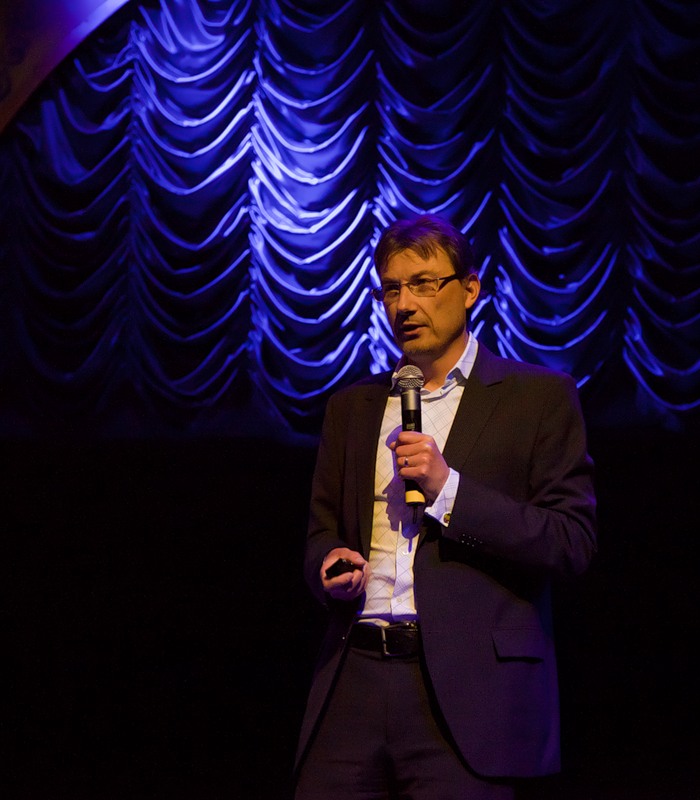Interview with XenSource founder Simon Crosby
 At the beginning of April, another Citrix partner conference was held in Moscow, in which Simon Crosby, Technical Director of the Cloud Computing and Data Centers division, took part. Simon is a very charismatic leader, with humor describing his position as the “main religious fanatic” on strategic development issues. He also stood at the origins of XenServer, was technical director at XenSource, which in 2007 was acquired by Citrix Systems.
At the beginning of April, another Citrix partner conference was held in Moscow, in which Simon Crosby, Technical Director of the Cloud Computing and Data Centers division, took part. Simon is a very charismatic leader, with humor describing his position as the “main religious fanatic” on strategic development issues. He also stood at the origins of XenServer, was technical director at XenSource, which in 2007 was acquired by Citrix Systems.In a special interview for the Citrix blog on Habré, Simon spoke about the commitment to the open source software development model and close cooperation with Microsoft, about the rivalry with VMware and the future of cloud systems. Simon is a consistent advocate of an “open” software development model, but at the same time largely disagree with Richard Stallman’s ideas. According to Crosby, open source is rather an effective tool for cooperation between companies and the community who are equally interested in developing an effective product. The XenServer hypervisor also has open source code after it goes under the wing and, by itself, is free. Community participation in the development allows you to release new versions of Xen twice a year, and free of charge, according to Simon, is a good way to “annoy” Citrix's main competitor in the field of server virtualization.
About XenSource
')
Xen was originally a project of the University of Cambridge, work on it began in the late 90s. Like many other academic projects, its source code was originally open. Over time, the project became popular, it began to use commercial companies that needed support. This was the reason for the formation of the company XenSource in 2005, and then Xen had two major advantages. First, we had open source, which was not the case with the main competitor - VMware. Secondly, Xen was then the only alternative to the products of this company. And since competition in any market is good, we have received strong support from companies like IBM. For example, they provided a secure hypervisor architecture, and the US National Security Agency participated in the development of encryption modules. More than 200 programmers were actively working on the project, and it developed at a very fast pace. We started with a serious lag from VMware, but caught up with them in just a year and a half.
When Citrix acquired XenSource in 2007, our server virtualization market share was about 3-4 percent. Now we have grown to 15-16 percent. Microsoft's Hyper-V hypervisor is also quickly gaining market share, so now VMware has a very serious market competition. Although they still lead, and this, they have to admit, is doing well.

About competitors and desktop virtualization
It should be understood that Citrix does not earn on the sale of server virtualization technologies. According to Gartner, only two products on the market are ready for use in large companies, on the most "heavy" projects. These are VMware vSphere and Citrix XenServer. At the same time, we do not monetize this market segment at all. Why? We believe that virtualized infrastructure is an essential, but not the main part of our core business, desktop virtualization. For the operation of many virtual desktops, a hypervisor is naturally needed, but this is not the main function, just one of many.
In this case, we have technologies that allow you to deploy private and public cloud systems based on XenServer. But this is also not the main part of the business. In this segment, we earn more on network solutions such as Citrix NetScaler. Network business brings a serious part of the income - for Citrix it is about $ 300 million a year. If you go back to desktop virtualization, I’m sure that by the end of next year we will be servicing a million servers with XenServer that provide only desktop virtualization.
We decided not to make money on server virtualization for several reasons. First, historically, this is not the main activity of the company. We have great partners, such as Microsoft with its System Center and Hyper-V, which provide infrastructure automation. Microsoft, like VMware, makes money on it, but we act differently. Citrix solutions are sold to people responsible for delivering user applications and desktops. They have always been our main customers. We simply focus on the strengths of our business, and in desktop virtualization we are the undisputed leader. Over the past three quarters, we have virtualized more than 10 million desktops.
About cloud computing
Any cloud system includes the Software as a Service and InfraStructure as a Service components. As for SaaS solutions, we are now the fourth largest supplier in the world and plan to further develop this area. We are also developing cloud-based IaaS solutions. We are participating in the development of the open source project OpenStack, which is the only alternative to the VMware vCloud initiative. The largest projects, such as RackSpace and Amazon EC2, work on our solutions.

Thanks to this experience, we know how to build large-scale public cloud systems. At the same time, we are not going to compete directly with VMware vCloud in the private cloud market. They sell IT automation system. We have never worked in this particular niche, although the cost of our cloud systems is now less than 1/20 of the cost of the same system on VMware solutions. We can develop open-source enterprise cloud systems that are fully automated and at a much lower price. Such systems can be used for desktop virtualization and in the development of next-generation web applications, and this is not about more and more advanced IT automation systems. We create enterprise cloud systems that allow application developers to simply develop applications. No connection with IT, this is the main difference. We are building clouds in which the presence of one specialist per 10 thousand servers is provided. And not one for a hundred or so, in the case of vCloud.
There are two directions for the development of cloud systems. In the first case, IT specialists use vCloud for more and more automation. We build developer-oriented clouds. Everything is done just for developers who create applications and implement them in cloud systems, in this case there is no talk about IT. Amazon EC2 is not served by people, they are not there at all.
I will sum up. Our cloud system model is fully automated, built on the basis of typical servers with local data storage, a large amount of RAM. The cost of owning such a system is 60% less compared to VMware solutions; it is the cheapest infrastructure for next-generation web applications.

About Citrix Development
Citrix is the fourth largest SaaS service provider, and this trend is developing very fast, especially in European countries. Business virtualization of desktops is developing at a slower rate, much faster than server virtualization. We can say that virtualized servers have captured 30-40, maybe 50% of the market, but virtualization of the remaining 50% is a very difficult task. Desktop virtualization technology, when a virtual user OS runs in a data center, is attractive to 15%, perhaps 30% of companies. This is not enough. What to do with the remaining 70% using “real” PCs?
We tried to answer this question by developing the embedded client hypervisor XenClient. It allows you to work with virtual desktops both when connected to a network and without it.
At the same time, it provides the same degree of reliability and security of corporate data as a classic virtual desktop. If a laptop with XenClient and corporate OS is stolen, it will still not be possible to read the encrypted data. If the laptop fails, I can continue to work at any time with the same copy of the virtual OS and the same data on another device. Therefore, we see serious potential for growth in XenClient, the solutions embedded in it are attractive for a wide range of companies, especially for those who need maximum data protection.
Another actively developing direction is new types of client devices, tablets, smartphones, and so on. These devices are included in the corporate work environment, and there is a need to access Windows applications from an iPhone, iPad or something like that. At the same time, a modern tablet is not a thin client, it has a powerful enough processor, a productive video system. Tablets have seriously impacted even the market for classic PCs, and our task is to provide access to data, user settings and applications on any device.
About open source
I’m sure that Open Source is the most productive software development model. Take for example Xen. The number of developers needed to create a truly successful hypervisor is about the same for us, for Microsoft or VMware. Only they have to hire 300 people for this, to provide working conditions for them, until they, working “from call to call,” release the product. In the open source world, things are completely different. Xen is developed 24 hours a day, worldwide, and I personally do not pay for it. Collective software development provides better code quality by evaluating the contribution of each member to the community. Thus, the quality of the code is higher, the development is ongoing, the most modern hardware is maintained. The finished product uses many companies in a variety of tasks.

We release significant updates for XenServer twice a year. Compare with other software vendors. VMware took three years to develop vSphere, Microsoft usually has a two-year development cycle. But we are not limited to XenServer. Our entire arsenal of cloud technologies, part of the OpenStack project, is fully open and being developed by the community. About 200 developers from 50 different companies are working daily on this project.
Such a platform requires maximum openness, so it must support any hypervisor, be as scalable as possible and ready to manage the largest clouds. Therefore, we also added support for ESX, Hyper-V, KVM hypervisors in OpenStack, not counting XenServer. This project is developing much faster than vCloud. In fact, if you estimate the rate at which vSphere converts to vCloud, you can conclude that OpenStack will get better support for VMware solutions than vCloud itself .
About cooperation with Microsoft
We have a wonderful relationship with Microsoft. Back in the days of XenSource, we had a separate team in Redmond that worked on Hyper-V, we were fully responsible for developing on the Linux side. And there were no problems. We also added Hyper-V support in OpenStack, and you can use the Microsoft hypervisor to build a large cloud system. We cooperate productively with Microsoft in the field of application delivery. But in the world of cloud technologies, we are absolutely confident that the customer should be able to use any hypervisor. By the way, XenServer is 100 percent compatible with Hyper-V. You can take a virtual machine from XenServer and just run it on the Microsoft hypervisor.
We try not to allow competition. Microsoft has a System Center with an extensive array of data center automation solutions. We do not do this, but for them it is a profitable business, they can compete in this direction with VMware. We are actively working in the field of desktop virtualization and application delivery.
Source: https://habr.com/ru/post/118142/
All Articles